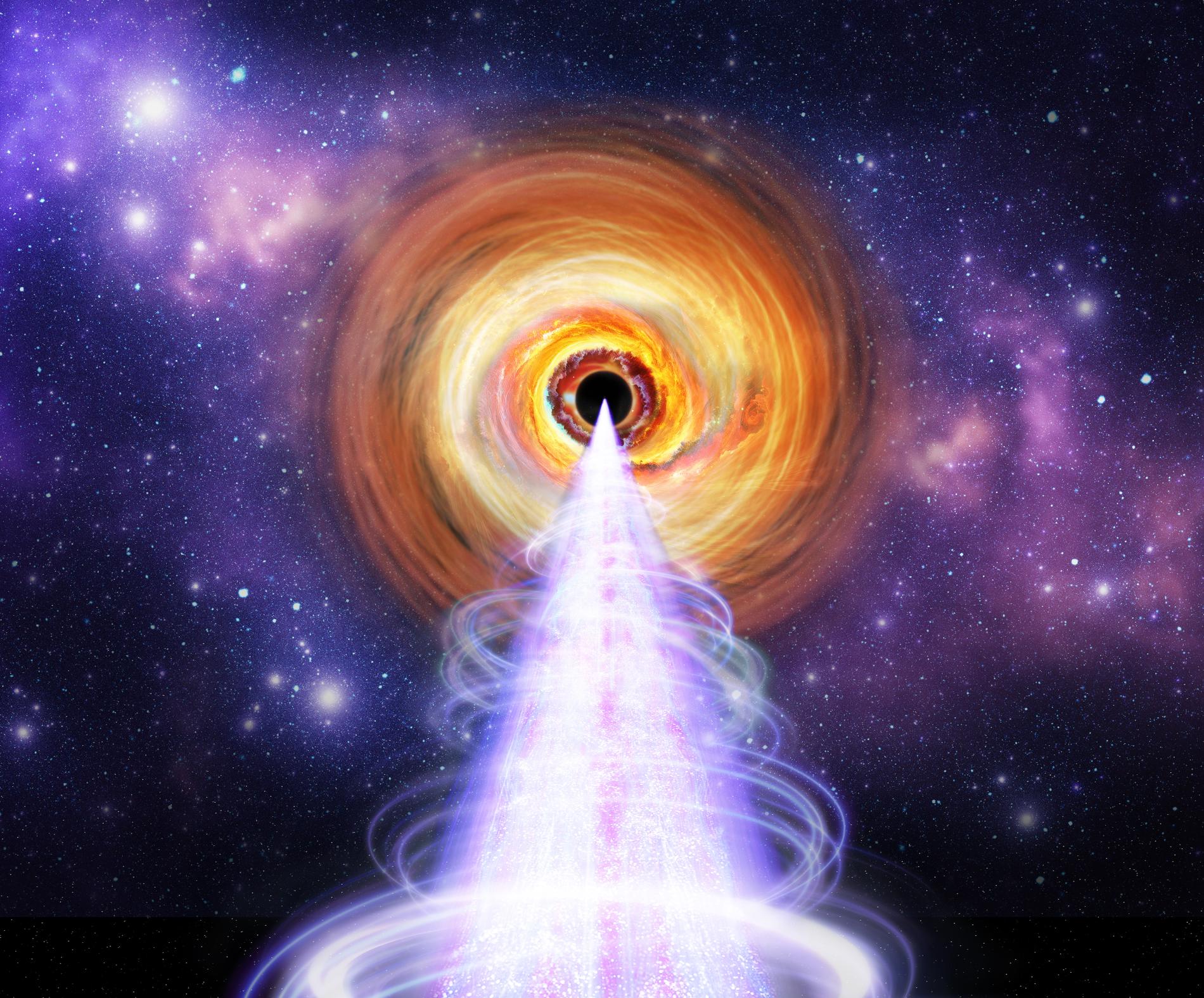A study led by the IAA-CSIC reveals the origin of X-ray emission in jets from supermassive black holes
The research, headed by the Instituto de Astrofísica de Andalucía (IAA-CSIC), solves a longstanding mystery about the particles responsible for X-ray emission in blazars
IXPE, the joint mission of NASA and the Italian Space Agency, along with the Sierra Nevada Observatory, played a key role in obtaining the data that enabled identification of the mechanism behind this extreme phenomenon
When the relativistic jet of an active galaxy is pointed directly at Earth, we witness one of the most extreme phenomena in the universe. This is the case with blazars: active galactic nuclei (AGN) powered by supermassive black holes that eject jets of matter at near-light speeds. In such cases, one of the jets is almost perfectly aligned with our line of sight. This orientation enhances the object’s brightness—due to the relativistic Doppler effect—and causes rapid and intense variations across the entire electromagnetic spectrum, from radio waves to gamma rays. One notable example is BL Lacertae, a blazar that offered a unique opportunity to tackle a long-standing astrophysical question: what physical mechanism produces X-ray emission in such extreme environments?
A recent study led by the Instituto de Astrofísica de Andalucía (IAA-CSIC) has shed light on this enigma. “This work, for the first time and without any ambiguity, resolves one of the oldest and most significant problems in the particle astrophysics of relativistic jets from supermassive black holes,” says Iván Agudo, IAA-CSIC researcher and lead author of the study. The findings, published in The Astrophysical Journal Letters, indicate that the X-ray emission in BL Lacertae arises from interactions between high-energy electrons and photons—particles of light—that dramatically boost the photons’ energy.

Artist's impression of the BL Lacertae. Credits: NASA
“These results would not have been possible without IXPE, the NASA and Italian Space Agency space mission specifically designed to observe polarized X-ray radiation from astronomical objects,” explains Jorge Otero, IAA-CSIC researcher (recently relocated to INFN-Padova, Italy) and a co-author of the study. “IXPE, where our group is the only Spanish participant on the science team, and the Sierra Nevada Observatory were key to analyzing the emission from BL Lacertae,” adds Iván Agudo (IAA-CSIC).

A Ball Aerospace engineer inspects the Imaging X-Ray Polarimetry Explorer (IXPE) spacecraft at Ball's test facility in Boulder, Colorado. Credits: NASA
THE POLARIZED LANGUAGE OF X-RAYS
Scientists had considered two possible mechanisms to explain X-ray emission in blazars: one involving protons, and another involving interactions between electrons and photons. Each process leaves a different signature in the polarization of X-ray light—a property that describes the orientation of electromagnetic waves.
High polarization in X-rays would point to a proton-related origin—either through their motion in the jet’s magnetic field or through collisions with photons—while lower polarization would suggest the responsible particles are electrons, via a mechanism known as Compton scattering. In this process, electrons transfer part of their energy to photons, boosting them to higher frequencies such as X-rays.
IXPE—the only active satellite capable of measuring X-ray polarization since its launch in December 2021—together with coordinated and intense optical polarization observations, proved essential for resolving this puzzle.
“This was one of the major mysteries about the jets from supermassive black holes,” says Iván Agudo (IAA-CSIC). “Thanks to IXPE, the optical polarimeter we recently installed at OSN, and support from other ground-based telescopes, we finally have the answer.”
The observations revealed a low degree of X-ray polarization and a very high degree in optical light, confirming that the X-rays in BL Lacertae are produced by Compton scattering of electrons traveling at relativistic speeds within the jet. These electrons are capable of transforming infrared light photons into X-ray photons.
A NEW WINDOW ON THE UNIVERSE
In late November 2023, the IXPE space telescope observed the blazar BL Lacertae (BL Lac)—one of the first blazars ever identified—for seven consecutive days. The campaign, conducted in coordination with ground-based telescopes (with the Sierra Nevada Observatory contributing most of the data), aimed to measure polarization in optical, millimeter, and radio wavelengths. Although IXPE had observed this object before, this campaign was especially significant: during the X-ray observations, the optical polarization of BL Lac reached an unusually high value of 47.5%.

Illustration of the IXPE mission telescope observing the polarisation of X-rays in space. Credits: NASA
“This was not only the highest polarization recorded for BL Lac in the last 30 years—it’s the highest ever observed in any blazar!” emphasizes Ioannis Liodakis, second author of the study and astrophysicist at the Institute of Astrophysics FORTH (Crete, Greece).
The VHEGA group at the Instituto de Astrofísica de Andalucía (IAA-CSIC) led this work within the IXPE science team. Particularly crucial were the optical polarimetry observations conducted at the Sierra Nevada Observatory (OSN), without which the team would not have been able to confirm the extremely high optical polarization in the blazar.

In the foreground, the Sierra Nevada Observatory (IAA-CSIC), in Granada (Spain). About 600 m away, and in the background, the 30 m IRAM Millimetre Radio Telescope, which also provided data for the work. Credits: OSN
Meanwhile, IXPE data revealed that the X-ray emission exhibited significantly lower polarization than the optical light. The team did not detect a strong X-ray polarization signal and determined that it does not exceed 7.4%, confirming that the radiation originates from Compton scattering, where electrons transfer energy to photons through collisions.
Jorge Otero (IAA-CSIC and INFN-Padova) highlights that “this study underscores the importance of combining X-ray observations with polarization measurements in optical and millimeter wavelengths, allowing us to fully harness the power of IXPE and future missions.” Moreover, the research has opened a new window into the universe, “marking the beginning of a true revolution in our understanding of astrophysical systems involving X-ray emission processes, magnetic fields, and light-scattering phenomena in asymmetric environments,” concludes Iván Agudo (IAA-CSIC).
- “High optical to X-ray polarization ratio reveals Compton scattering in BL Lacertae’s jet”
- https://arxiv.org/abs/2505.01832
-
-
Iván Agudo - iagudo@iaa.es
-
- Instituto de Astrofísica de Andalucía (IAA-CSIC)
- Unidad de Divulgación y Comunicación
- Amanda López – alm@iaa.es
- Emilio García – garcia@iaa.es - 649 407 445 (vía whatssap)
- Celia Navas - navas@iaa.es
- https://www.iaa.csic.es
- https://divulgacion.iaa.csic.es

